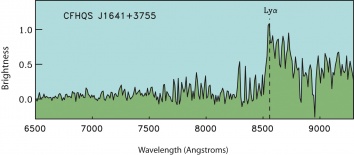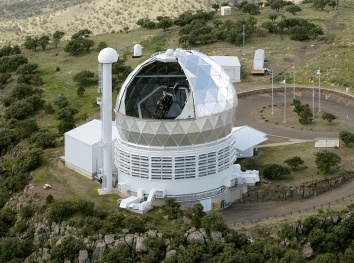Hobby-Eberly Telescope Helps Astronomers Learn Secrets of One of Universe's Most Distant Objects
8 July 2007
FORT DAVIS, Texas — Astronomers have used the 9.2-meter Hobby-Eberly Telescope (HET) at McDonald Observatory to confirm one of the most distant known objects in the universe. The object is a quasar — an extremely bright galaxy nucleus powered by matter falling into a supermassive black hole at its heart — that is 12.7 billion light-years away. Because light travels at a finite speed, we are seeing this quasar as it appeared 12.7 billion years ago, when the universe was just 7 percent of its present age.
The object was discovered by the Canada-France High-z Quasar Survey, which has been undertaken by an international group using the Canada-France-Hawaii Telescope on Mauna Kea, Hawaii. The survey team, headed by Chris Willott of the University of Ottawa, presented their results on four extremely distant quasars, including this one, this week at the annual conference of the Canadian Astronomical Society in Kingston, Ontario.
It is particularly important to find such distant quasars because they can be used to probe a time in cosmic history called the “Era of Re-ionization,” said Gary Hill, a member of the survey team and McDonald Observatory’s Chief Astronomer. During this time, he said, the earliest stars were forming and beginning to turn the universe from mostly neutral atoms to mostly ionized (where they have lost their electrons due to ultraviolet radiation). The era lasted about half a billion years.
He explained that the distant quasars are seen early enough in the history of the universe that they shine through regions of space that were not yet fully ionized. Some of the quasar’s light is absorbed by any clouds of still-neutral hydrogen. So, by studying the quasar’s light today, astronomers can gauge what types of gas clouds the light has passed through on its way to Earth — providing a record of when in time and where in space these gas clouds lived.
Fewer than 10 such distant quasars were previously known, Hill said, so “every one of these counts. Every one you add gives you another line of sight,” — a way to probe a different part of the universe and study the inhomogeneous re-ionization process.
Follow-up observations of this specific quasar (with the somewhat difficult moniker “CFHQS 1641+3755”) were first made in the infrared with the 2.7-meter Harlan J. Smith Telescope at McDonald Observatory to indicate that it is probably a quasar, and not a brown dwarf (both objects are point-like and red in color in photos).
That accomplished, it was then sent to be studied by HET. The large light-gathering power of this telescope, the world’s fourth-largest, combined with its Marcario Low Resolution Spectrograph, allowed astronomers to measure a spectrum of the quasar and calculate its distance of 12.7 billion light-years (in astronomical jargon, this equates to a redshift of z = 6.04).
The difficult HET observation was carried out by Michael Gully-Santiago, a college student astronomer from Boston University spending the summer at McDonald Observatory. Gully-Santiago was taking part in the observatory’s Research Experiences for Undergraduates program, which is funded by the National Science Foundation.
The group plans to continue following up quasars from the Canada-France survey with HET, Hill said. They have submitted their results to the Astronomical Journal for publication. A copy of this paper is available online at http://arxiv.org/abs/0706.0914.
The Hobby-Eberly Telescope is a joint project of The University of Texas at Austin, The Pennsylvania State University, Stanford University, Ludwig-Maximilians-Universität München and Georg-August-Unversität Göttingen.
— END —
Note to Editors : For more information contact Gary Hill at 512-471-1477 or hill@astro.as.utexas.edu.







